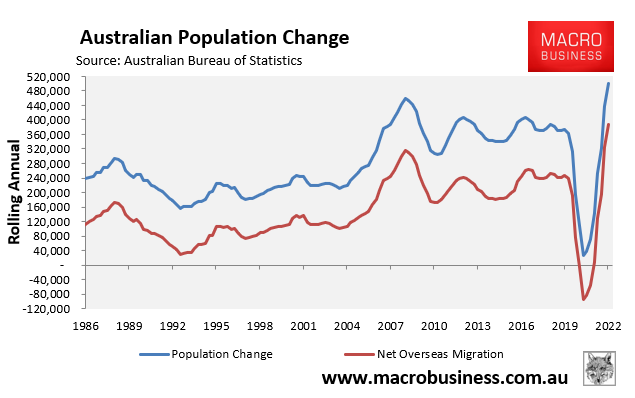Given that two of Prime Minister Anthony Albanese’s major initiatives — ‘net zero’ glasshouse gas emissions and expanding Australia’s immigration levels — are at odds, the Labor government must explain to Australians how it plans to achieve both.
This year, Australia’s population surpassed 26 million following record immigration-driven population growth:

According to the Australian Bureau of Statistics (ABS), Australia’s population expanded by more than 500,000 people in a single year for the first time in the nation’s history in 2022, driven by unprecedented net overseas migration (NOM) of 387,000.
The Albanese government has also projected record population growth for Australia.
The 2023 federal budget projected a 2.18 million population increase (equivalent to a Perth) over the five years to 2026-27, driven by NOM of 1.5 million (equivalent to an Adelaide).
The 2023 Intergeneration Report, released last week, projected a 14.2 million population increase – equivalent to a combined Sydney, Melbourne, Brisbane and Adelaide – over the 40 years to 2062-63, again driven by strong NOM.

The Albanese government claims that more migrants are needed for economic growth due to Australia’s low domestic birth rate and ageing population.
Rapid population growth, however, is associated with higher greenhouse gas emissions as a result of the increased economic activity required to accommodate new immigrants.
This is true for practically all goods and services because they all need fossil fuel energy.
It is estimated that building construction, operation, and maintenance account for around one-quarter of Australia’s greenhouse gas emissions.
The addition of 14.2 million people, at least 5.5 million additional housing units, millions of motor vehicles, and huge volumes of infrastructure (including water desalination plants) will dramatically increase Australia’s carbon emissions and will result in the paving over of hundreds of thousands of hectares of Australia’s best farmland.
Again, it is the equivalent of adding a Sydney, Melbourne, Brisbane and Adelaide on Australia’s landscape. This quantity of immigration and its environmental consequences are enormous.
The 2021 State of the Environment (SoE) Report, compiled by a panel of experts for the federal government, rated pressures from population growth as having a “very high impact” on the environment:

As part of a transition to “net zero” emissions by 2050, the Albanese Government has promised to reduce Australia’s carbon emissions by 43% in 2030 compared to 2005.
How can Australia attain “net zero” while its population is expected to rise by 14.2 million people, or 54%?
What about the broader environmental consequences of land removal and resource use by the increased population, as laid out in the 2021 SoE report?
Increased population, primarily due to high immigration levels, will result in higher greenhouse gas emissions and environmental degradation.
How will the Albanese government deliver both “net zero” and a substantially larger population?
The Albanese government must explain to Australians how it intends to reduce emissions and safeguard the natural environment in the face of a 14.2 million expansion in the population fuelled by immigration.

